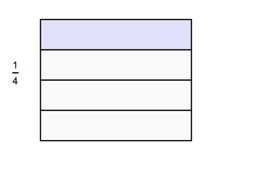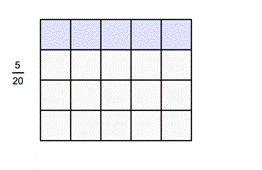

Simplifying Fractions
Fractions are used to represent a part of a whole. Fractions that represent the same part of a whole are called equivalent fractionsTwo or more fractions that name the same part of the whole. . Factoring, multiplication, and division are all helpful tools for working with equivalent fractions.
We use equivalent fractions every day. Fifty cents can be `2` quarters, and we have `2/4` of a dollar, because there are `4` quarters in a dollar. Fifty cents is also `50` pennies out of `100` pennies, or `50/100` of a dollar. Both of these fractions are the same amount of money, but written with a different numerator and denominator.
Think about a box of crackers that contains `3` packets of crackers. Two of these packets are `2/3` of the box. Suppose each packet has `30` crackers in it. Two packets are also `60` (`30*2`) crackers out of `90` (`30*3`) crackers. This is `60/90` of the box. The fractions `2/3` and `60/90` both represent two packets of crackers, so they are equivalent fractions.
Equivalent fractions represent the same part of a whole, even if the numerator and denominator are different. For example, `1/4=5/20`. In these diagrams, both fractions represent one of four rows in the rectangle.


Since `1/4` and `5/20` are naming the same part of a whole, they are equivalent.
There are many ways to name the same part of a whole using equivalent fractions.
Let’s look at an example where you need to find an equivalent fraction.
|
Example |
||
|
Problem
|
John is making cookies for a bake sale. He made `20` large cookies, but he wants to give away only `3/4` of them for the bake sale. What fraction of the cookies does he give away, using `20` as the denominator? |
|
|
|
|
Start with `20` cookies. |
|
|
|
Because the denominator of `3/4` is `4`, make `4` groups of cookies, `5` in each group. |
|
|
|
`3/4=(3*5)/(4*5)` because there are `5` cookies in each group.
`3/4=(3*5)/(4*5)=15/20` |
|
Answer |
He gives away `15/20` of the cookies. |
|
When you regroup and reconsider the parts and whole, you are multiplying the numerator and denominator by the same number. In the above example, you multiply `4` by `5` to get the needed denominator of `20`, so you also need to multiply the numerator `3` by `5`, giving the new numerator of `15`.
|
Finding Equivalent Fractions
To find equivalent fractions, multiply or divide both the numerator and the denominator by the same number.
Examples: `20/25=(20-:5)/(25-:5)=4/5`
`2/7=(2*6)/(7*6)=12/42`
|
|
Write an equivalent fraction to `2/3` that has a denominator of `27`.
A) `26/27`
B) `11/27`
C) `18/27`
D) `12/18`
|
A fraction is in its simplest formA fraction is in simplest form if the numerator and denominator have no common factors other than `1`., or lowest termsA fraction is in lowest terms if the numerator and denominator have no common factors other than `1`. , when it has the least numerator and the least denominator possible for naming this part of a whole. The numerator and denominator have no common factor other than `1`.
Here are `10` blocks, `4` of which are green. So, the fraction that is green is `4/10`. To simplify, you find a common factor and then regroup the blocks by that factor.
|
Example |
||
|
Problem |
Simplify `4/10`. |
|
|
|
|
We start with `4` green blocks out of `10` total blocks. |
|
|
|
Group the blocks in twos, since `2` is a common factor. You have `2` groups of green blocks and a total of `5` groups, each group containing `2` blocks. |
|
|
|
Now, consider the groups as the part and you have `2` green groups out of `5` total groups. |
|
Answer |
`4/10=2/5` The simplified fraction is `2/5`. |
|
Once you have determined a common factor, you can divide the blocks into the groups by dividing both the numerator and denominator to determine the number of groups that you have.
For example, to simplify `6/9` you find a common factor of `3`, which will divide evenly into both `6` and `9`. So, you divide `6` and `9` into groups of `3` to determine how many groups of `3` they contain. This gives `(6-:3)/(9-:3)=2/3`, which means `2` out of `3` groups, and `2/3` is equivalent to `6/9`.
It may be necessary to group more than one time. Each time, determine a common factor for the numerator and denominator using the tests of divisibility, when possible. If both numbers are even numbers, start with `2`. For example:
|
Example |
||
|
Problem |
Simplify `32/48`. |
|
|
|
`32/48=(32-:2)/(48-:2)=16/24` |
`32` and `48` have a common factor of `2`. Divide each by `2`. |
|
|
`16/24=(16-:2)/(24-:2)=8/12` |
`16` and `24` have a common factor of `2`. Divide each by `2`. |
|
|
`8/12=(8-:4)/(12-:4)=2/3` |
`8` and `12` have a common factor of `4`. Divide each by `4`. |
|
|
|
|
|
Answer |
`32/48=2/3` |
`2/3` is the simplified fraction equivalent to `32/48`. |
In the example above, `16` is a factor of both `32` and `48`, so you could have shortened the solution.
`32/48=(2*16)/(3*16)=2/3`
You can also use prime factorizationA number written as the product of its prime factors. to help regroup the numerator and denominator.
|
Example |
||
|
Problem |
Simplify `54/72`. |
|
|
|
`54/72=(2*3*3*3)/(2*2*2*3*3` |
The prime factorization of `54` is `2*3*3*3`. The prime factorization of `72` is `2*2*2*3*3`. |
|
|
`(3*(2*3*3))/(2*2*(2*3*3))` |
Rewrite, finding common factors. |
|
|
`3/(2*2)*1` |
`(2*3*3)/(2*3*3)=1` |
|
|
`3/4` |
Multiply: `2*2`. |
|
Answer |
`54/72=3/4` |
`3/4` is the simplified fraction equivalent to `54/72`. |
Notice that when you simplify a fraction, you divide the numerator and denominator by the same number, in the same way you multiply by the same number to find an equivalent fraction with a greater denominator. In the example above, you could have divided the numerator and denominator by `9`, a common factor of `54` and `72`.
`(54-:9)/(72-:9)=6/8`
Since the numerator (`6`) and the denominator (`8`) still have a common factor, the fraction is not yet in lowest terms. So, again divide by the common factor `2`.
`(6-:2)/(8-:2)=3/4`
Repeat this process of dividing by a common factor until the only common factor is `1`.
|
Simplifying Fractions to Lowest Terms
To simplify a fraction to lowest terms, divide both the numerator and the denominator by their common factors. Repeat as needed until the only common factor is `1`.
|
|
Simplify `36/72`.
A) `3/6`
B) `9/18`
C) `18/38`
D) `1/2`
|
Equivalent fractions do not always have the same numerator and denominator, but they have the same value. A fraction is in lowest terms when the numerator and denominator of the fraction share no common factors other than `1`. A fraction written in lowest terms is called a simplified fraction.